Best Machine Learning Books (Updated for 2020)
The list of the best machine learning & deep learning books for 2020.

New year, new books! As I did last year, I've come up with the best recently-published titles on deep learning and machine learning. I did my fair share of digging to pull together this list so you don't have to.
Here it is — the list of the best machine learning & deep learning books for 2020:
- Hands-On Machine Learning with Scikit-Learn and TensorFlow (2nd Edition) by Aurélien Géron
- The Hundred-Page Machine Learning Book by Andriy Burkov
- Building Machine Learning Powered Applications: Going from Idea to Product by Emmanuel Ameisen
- Grokking Deep Learning by Andrew W. Trask
- Deep Learning with Python by Francois Chollet
- Deep Learning by Ian Goodfellow, Yoshua Bengio, Aaron Courville
- Reinforcement Learning: An Introduction (2nd Edition) by Richard S. Sutton, Andrew G. Barto
- Deep Reinforcement Learning Hands-On (2nd Edition) by Maxim Lapan
- TinyML: Machine Learning with TensorFlow Lite on Arduino and Ultra-Low-Power Microcontrollers by Pete Warden & Daniel Situnayake
- Learning From Data by Yaser S. Abu-Mostafa, Malik Magdon-Ismail, Hsuan-Tien Lin.
- The Book of Why by Judea Pearl, Dana Mackenzie.
- Rebooting AI by Gary Marcus & Ernest Davis
- Machine Learning Yearning by Andrew Ng.
- An Introduction to Machine Learning Interpretability (2nd Edition) by Patrick Hall & Navdeep Gill
- Interpretable Machine Learning by Christoph Molnar.
- Neural Networks and Deep Learning by Michael Nielsen.
- Generative Deep Learning by David Foster
Coming Soon
- Deep Learning for Coders with fastai and PyTorch: AI Applications Without a PhD by Jeremy Howard & Sylvain Gugger
- The Machine Learning Engineering Book by Andriy Burkov
- Machine Learning Interviews Book by Chip Huyen
- Human-in-the-Loop Machine Learning by Robert Munro
Hands-On Machine Learning with Scikit-Learn and TensorFlow
Concepts, Tools, and Techniques to Build Intelligent Systems (2nd edition)
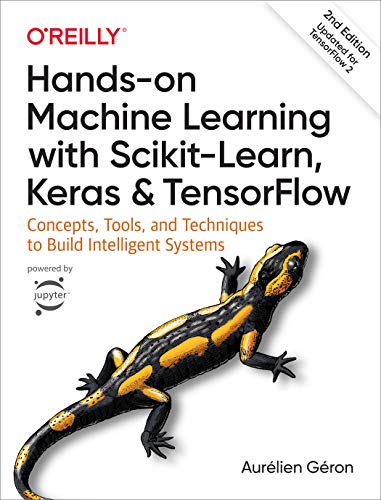
Author: Aurélien Géron.
Categories: Machine & Deep Learning.
Why you should read it:
Aurélien shines as a great communicator of ideas and uses examples effectively. You'll get to apply what you are learning pretty quickly as you work through the book. To get a feel for Aurélien's passion and communication style, check out his YouTube channel.
If you are looking for something that mixes theory with practice, go ahead and just buy it! It’s also strongly recommended for those of you who want to just get started with a practical approach.
Where you can get it: You can get the second edition on Amazon or O'Reilly Shop.
Supplement: You can find the companion code on Github.
What's new in the Second Edition: Code updated for TensorFlow-2.0. In particular, it covers tf.keras, tf.data, distribution strategies, as well as tf.hub, tfds, tf-agents, and more! A couple of extra chapters on unsupervised learning tasks (clustering, anomaly detection, density estimation), NLP (RNN, attention, transformer) and training & deployment at scale. Previous content is also covered deeper.
Hurray!!! 🥳 The 2nd edition of my book is available on Kindle (https://t.co/YDQvW5MC8u) and eBooks (https://t.co/SMxYdo2Vu3)! The paper edition should be available within ~2 weeks. 🦎 pic.twitter.com/pQ9OuIzsVF
— Aurélien Geron (@aureliengeron) September 7, 2019
A nice review of what is also my own favorite book on machine learning. @aureliengeron has created a masterpiece. It is one of the best books @OReillyMedia has published in our entire history. https://t.co/Yowc7xT8PS
— Tim O'Reilly (@timoreilly) January 11, 2020
Book abstract (2nd edition):
Through a series of recent breakthroughs, deep learning has boosted the entire field of machine learning. Now, even programmers who know close to nothing about this technology can use simple, efficient tools to implement programs capable of learning from data.
The updated edition of this best-selling book uses concrete examples, minimal theory, and two production-ready Python frameworks—Scikit-Learn and TensorFlow 2.0—to help you gain an intuitive understanding of the concepts and tools for building intelligent systems. Practitioners will learn a range of techniques that they can quickly put to use on the job. Part 1 employs Scikit-Learn to introduce fundamental machine learning tasks, such as simple linear regression. Part 2, which has been significantly updated, employs Keras and TensorFlow 2.0 to guide the reader through more advanced machine learning methods using deep neural networks. With exercises in each chapter to help you apply what you’ve learned, all you need is programming experience to get started.
NEW FOR THE SECOND EDITION:Updated all code to TensorFlow 2.o Introduced the high-level Keras API. New and expanded coverage including TensorFlow’s Data API, Eager Execution, Estimators API, deploying on Google Cloud ML, handling time series, embeddings and more.
The Hundred-Page Machine Learning Book

Author: Andriy Burkov.
Categories: Machine & Deep Learning.
Why you should read it:
The book was born from a challenge on LinkedIn, (where Andriy is an influencer and has Top Voice distinction for his reach on that platform). His book doesn't need too much of an introduction; it’s the Amazon best seller in its category and probably the best condensed collection of knowledge on the topic.
Where you can get it: Buy on Amazon. This book is distributed on the “read first, buy later” principle, which means you can freely download the book, read it, and share it with your friends and colleagues, and if you liked the book or found it useful for your work or studies then buy it.
Supplement: You can find the companion wiki and the code examples on Github.
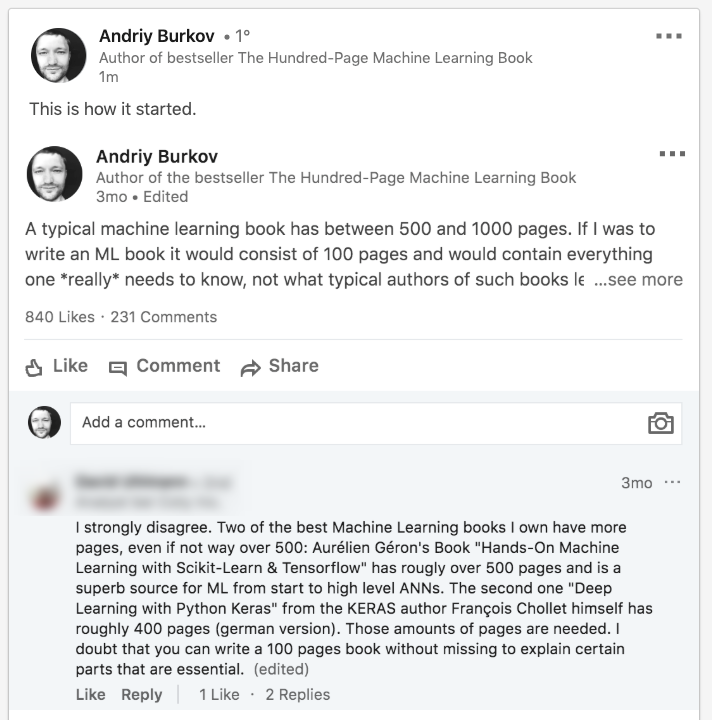
Here is what the experts think:
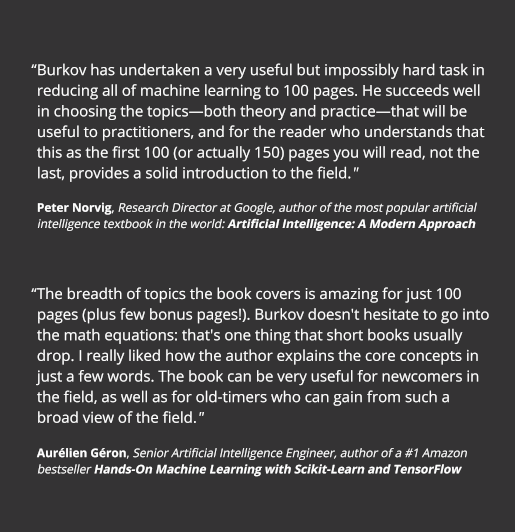
Building Machine Learning Powered Applications: Going from Idea to Product

Author: Emmanuel Ameisen.
Categories: Machine & Deep Learning.
Why you should read it:
It's 2020 and we all want to do one thing: bring ML models to production. How can you do this? Emmauel has structured the book in a way that follows the same lifecycle applied in industry: from heuristics (to establish a baseline) to model iterations.
This title is highly recommended if you're planning to invest more seriously & rigorously in the AI transformation.
Where you can get it: Buy on Amazon or O'Reilly Shop.
Supplement: dedicated book page and the code examples on Github.
13 months. 250 pages. I wrote an ML book!
— Emmanuel Ameisen (@mlpowered) July 25, 2019
Want to learn how to ship ML in practice? Check it out!
Includes tips from @WWRob, @mrogati, @cdubhland and more!
It'll be out in winter & you can preorder it now.
Amazon: https://t.co/phfPrTxjCx
O'Reilly: https://t.co/Getosvuuja pic.twitter.com/PRD5PLfg5S
Book abstract:
Learn the skills necessary to design, build, and deploy applications powered by machine learning (ML). Through the course of this hands-on book, you’ll build an example ML-driven application from initial idea to deployed product. Data scientists, software engineers, and product managers—including experienced practitioners and novices alike—will learn the tools, best practices, and challenges involved in building a real-world ML application step by step.
Author Emmanuel Ameisen, an experienced data scientist who led an AI education program, demonstrates practical ML concepts using code snippets, illustrations, screenshots, and interviews with industry leaders. Part I teaches you how to plan an ML application and measure success. Part II explains how to build a working ML model. Part III demonstrates ways to improve the model until it fulfills your original vision. Part IV covers deployment and monitoring strategies.
This book will help you:
- Define your product goal and set up a machine learning problem
- Build your first end-to-end pipeline quickly and acquire an initial dataset
- Train and evaluate your ML models and address performance bottlenecks
- Deploy and monitor your models in a production environment
Grokking Deep Learning

Author: Andrew W. Trask.
Categories: Machine & Deep Learning.
Why you should read it:
Andrew Trask is the force behind OpenMined, an open-source community focused on researching, developing, and promoting tools for secure, privacy-preserving, value-aligned artificial intelligence. I'm quite sure that you’ve enrolled in his Udacity course sponsored by Facebook, Secure & Private AI. (If you didn't, you should do it now—it's free! He also writes a great blog. No surprises on his book making our list. Yes, he's a FloydHub friend. No, we're not biased.
We really loved the first principles approach of learning from the ground up, teaching us the math behind neural networks using low-level building blocks with NumPy. This is probably the best approach to follow to learn how Deep Learning works behind the scenes.
Where you can get it: Buy on Amazon or Manning publications.
Supplement: You can find the companion code on Github.
Prerequisites: For readers with high school-level math and intermediate programming skills.
Book abstract:
Grokking Deep Learning teaches you to build deep learning neural networks from scratch! In his engaging style, seasoned deep learning expert Andrew Trask shows you the science under the hood, so you grok for yourself every detail of training neural networks. Using only Python and its math-supporting library, NumPy, you'll train your own neural networks to see and understand images, translate text into different languages, and even write like Shakespeare! When you're done, you'll be fully prepared to move on to mastering deep learning frameworks.
Deep Learning with Python

Author: Francois Chollet.
Category: Deep Learning.
Why you should read it:
From the Keras inventor (and another FloydHub friend), this book will take you by the hand and lead you through mesmerizing mazes of Deep Learning — with Keras, of course. Similar to Grokking Deep Learning, this book strikes the right balance between theory and coding. A bonus is Francois's impressive ability to create great mental images.
Writing my deep learning book. I am pretty bad at writing, but hopefully I am better at mental images. pic.twitter.com/c5zJbknXZn
— François Chollet (@fchollet) July 18, 2016
Wondering if there will be a second edition? You can bet on it.
Yes, there will be a 2nd edition (probably by late 2019)
— François Chollet (@fchollet) March 11, 2019
Where you can get it: Buy on Amazon, Manning publications or O'Reilly.
Supplement: You can find the companion code on Github.
Prerequisites: Readers need intermediate Python skills. No previous experience with Keras, TensorFlow, or machine learning is required.
Book abstract:
Deep Learning with Python introduces the field of deep learning using the Python language and the powerful Keras library. Written by Keras creator and Google AI researcher François Chollet, this book builds your understanding through intuitive explanations and practical examples. You'll explore challenging concepts and practice with applications in computer vision, natural-language processing, and generative models. By the time you finish, you'll have the knowledge and hands-on skills to apply deep learning in your own projects.
Deep Learning

Authors: Ian Goodfellow, Yoshua Bengio, Aaron Courville.
Category: Deep Learning.
Why you should read it:
This book is widely considered to be the Bible of Deep Learning. Written by three experts, including one of the godfathers of the field, this is the most comprehensive book you can find on the subject. The book is extremely technical & full of math, but the authors do a great job at explaining everything.
But it’s definitely not recommended reading if you’re just starting your Deep Learning journey or if you lack a solid algebraic foundation.
Where you can get it: Buy on Amazon or read here for free.
Supplement: You can also find the lectures with slides and exercises on GitHub.
Book abstract:
Deep learning is a form of machine learning that enables computers to learn from experience and understand the world in terms of a hierarchy of concepts. Because the computer gathers knowledge from experience, there is no need for a human computer operator to formally specify all the knowledge that the computer needs. The hierarchy of concepts allows the computer to learn complicated concepts by building them out of simpler ones; a graph of these hierarchies would be many layers deep. This book introduces a broad range of topics in deep learning.
The text offers mathematical and conceptual background, covering relevant concepts in linear algebra, probability theory and information theory, numerical computation, and machine learning. It describes deep learning techniques used by practitioners in industry, including deep feedforward networks, regularization, optimization algorithms, convolutional networks, sequence modeling, and practical methodology; and it surveys such applications as natural language processing, speech recognition, computer vision, online recommendation systems, bioinformatics, and videogames. Finally, the book offers research perspectives, covering such theoretical topics as linear factor models, autoencoders, representation learning, structured probabilistic models, Monte Carlo methods, the partition function, approximate inference, and deep generative models.
Deep Learning can be used by undergraduate or graduate students planning careers in either industry or research, and by software engineers who want to begin using deep learning in their products or platforms. A website offers supplementary material for both readers and instructors.
Reinforcement Learning: An Introduction (2nd Edition)
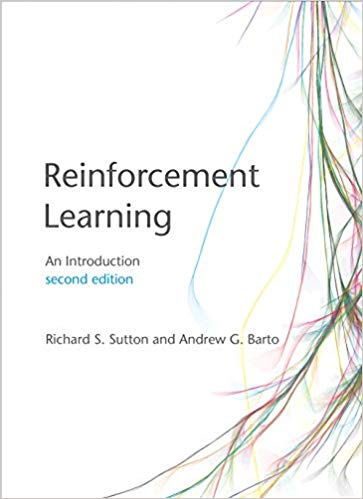
Authors: Richard S. Sutton, Andrew G. Barto.
Categories: Machine Learning, Reinforcement Learning, Deep Learning, Deep Reinforcement Learning, Artificial Intelligence.
Why you should read it:
If Deep Learning is considered the Bible of that subject, this masterpiece earns that title for Reinforcement Learning. If you want to get started in RL, this is the way. Just like you may have predicted (pat on the back for you), this is a pretty technical read. Our advice is to take a break after each chapter, load up on the coffee, and actually implement the algorithms (à la these famous repos).
Where you can get it: Buy on Amazon. You can read the final draft of 2nd edition for free.
Book abstract:
Reinforcement learning, one of the most active research areas in artificial intelligence, is a computational approach to learning whereby an agent tries to maximize the total amount of reward it receives while interacting with a complex, uncertain environment. In Reinforcement Learning, Richard Sutton and Andrew Barto provide a clear and simple account of the field's key ideas and algorithms. This second edition has been significantly expanded and updated, presenting new topics and updating coverage of other topics.
Like the first edition, this second edition focuses on core online learning algorithms, with the more mathematical material set off in shaded boxes. Part I covers as much of reinforcement learning as possible without going beyond the tabular case for which exact solutions can be found. Many algorithms presented in this part are new to the second edition, including UCB, Expected Sarsa, and Double Learning. Part II extends these ideas to function approximation, with new sections on such topics as artificial neural networks and the Fourier basis, and offers expanded treatment of off-policy learning and policy-gradient methods. Part III has new chapters on reinforcement learning's relationships to psychology and neuroscience, as well as an updated case-studies chapter including AlphaGo and AlphaGo Zero, Atari game playing, and IBM Watson's wagering strategy. The final chapter discusses the future societal impacts of reinforcement learning.
Deep Reinforcement Learning Hands-On
Apply modern RL methods to practical problems of chatbots, robotics, discrete optimization, web automation, and more, 2nd Edition
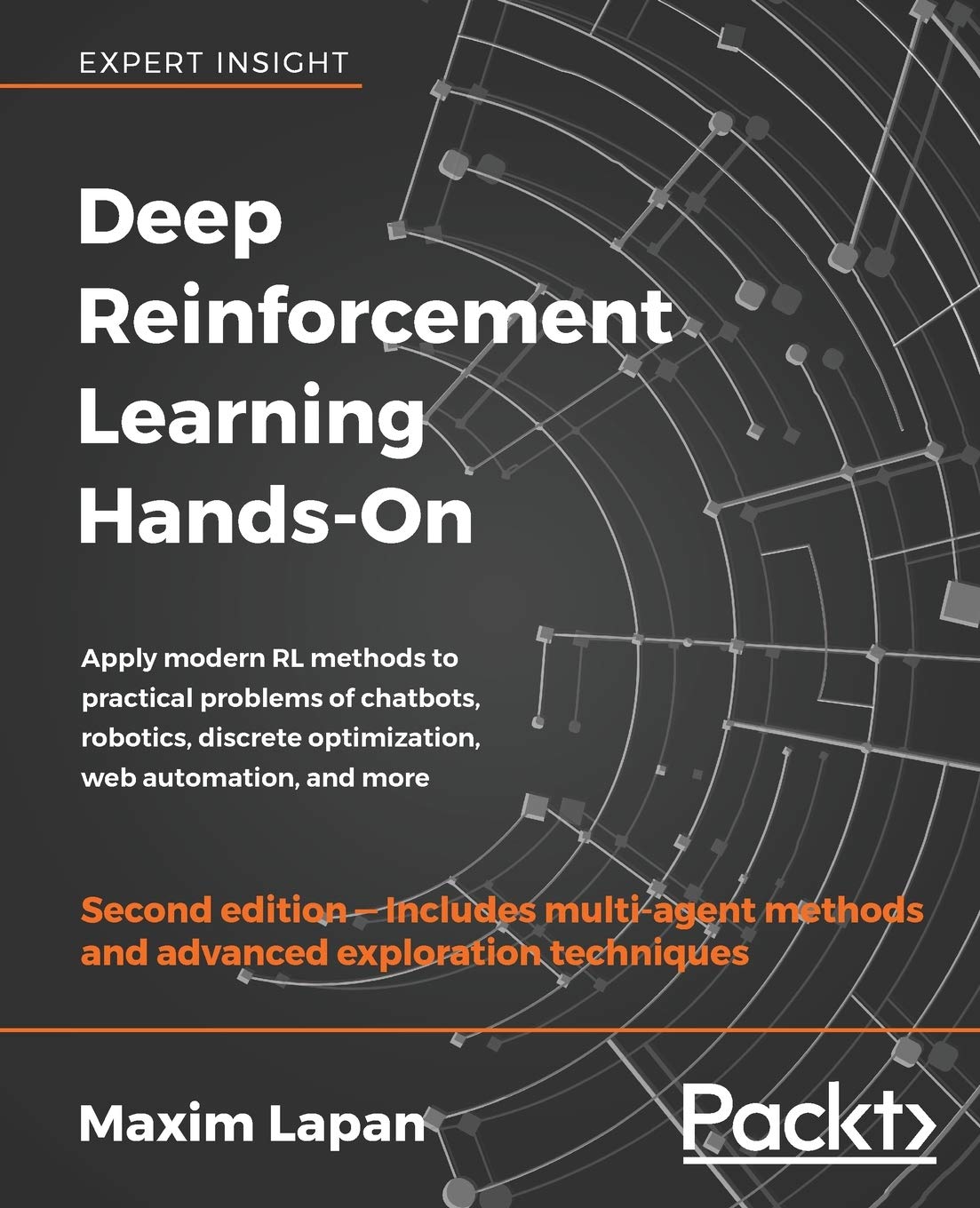
Authors: Maxim Lapan.
Categories: Machine Learning, Reinforcement Learning, Deep Learning, Deep Reinforcement Learning, Artificial Intelligence
Why you should read it:
I came across Maxim's book from one of his blog posts. I literally fell in love with his writing style and the attention to detail (and I imagine you will, too). This book offers a practical approach to RL by balancing theory with coding practice. It’s a book to get your hands dirty with—but first, one that will give you a ton of knowledge about how to do it correctly and understand what is happening behind the scenes. In my opinion, it’s the best hands-on style book on RL.
Highly recommended for all the readers who want to get started on RL and are looking for the perfect tradeoff between theory & practice.
Where you can get it: Buy on Amazon or Packt.
Supplement: You can find the companion code on Github.
What's new: Revised and expanded to include multi-agent methods, discrete optimization, RL in robotics, advanced exploration techniques, and more.
Book abstract:
Deep Reinforcement Learning Hands-On, Second Edition is an updated and expanded version of the bestselling guide to the very latest reinforcement learning (RL) tools and techniques. It provides you with an introduction to the fundamentals of RL, along with the hands-on ability to code intelligent learning agents to perform a range of practical tasks.
With six new chapters devoted to a variety of up-to-the-minute developments in RL, including discrete optimization (solving the Rubik's Cube), multi-agent methods, Microsoft's TextWorld environment, advanced exploration techniques, and more, you will come away from this book with a deep understanding of the latest innovations in this emerging field.
In addition, you will gain actionable insights into such topic areas as deep Q-networks, policy gradient methods, continuous control problems, and highly scalable, non-gradient methods. You will also discover how to build a real hardware robot trained with RL for less than $100 and solve the Pong environment in just 30 minutes of training using step-by-step code optimization.
In short, Deep Reinforcement Learning Hands-On, Second Edition, is your companion to navigating the exciting complexities of RL as it helps you attain experience and knowledge through real-world examples.
TinyML: Machine Learning with TensorFlow Lite on Arduino and Ultra-Low-Power Microcontrollers

Authors: Pete Warden & Daniel Situnayake.
Categories: Machine Learning, Edge Deployment.
Why you should read it:
“Why the future of Machine Learning is tiny” was published by Pete about a year ago, but that article is still of great relevance and importance right now, as its central thesis remains true: "there’s a massive untapped market waiting to be unlocked with the right technology."
In this book, Pete and his co-author argue that the reason to deploy at the edge is pretty simple: given the Industry 4.0 trends about IoT, there are billions of micro-controllers out there with hardcoded tasks that consume thousands of sensor data per second, but most of this data is unfortunately wasted.
But what technology is able to process multiple data and at the same time make autonomous decisions? Bingo, Machine Learning models. Recent techniques are making deep learning models smaller & smaller without losing accuracy, and this book’s authors will show you how to do it properly. If you want to be at the forefront of the next ML disruption, you’ll want to prepare yourself with this book.
Where you can get it: Buy on Amazon or O'Reilly Shop.
Supplement: Dedicated page. Code on TensorFlow GitHub.
It's finally done! Our #TinyML book has been sent for printing 🥳🍾 @petewarden and I can't wait to see what you think of it 😊
— Daniel Situnayake (@dansitu) December 16, 2019
The finished ebook will be available later this week, and print books will start appearing within a month. More details here👇https://t.co/T7L1HQPdRM pic.twitter.com/ClbQVccAMA
Book abstract:
Deep learning networks are getting smaller. Much smaller. The Google Assistant team can detect words with a model just 14 kilobytes in size—small enough to run on a microcontroller. With this practical book you’ll enter the field of TinyML, where deep learning and embedded systems combine to make astounding things possible with tiny devices.
Pete Warden and Daniel Situnayake explain how you can train models small enough to fit into any environment. Ideal for software and hardware developers who want to build embedded systems using machine learning, this guide walks you through creating a series of TinyML projects, step-by-step. No machine learning or microcontroller experience is necessary.
Build a speech recognizer, a camera that detects people, and a magic wand that responds to gestures
- Work with Arduino and ultra-low-power microcontrollers
- Learn the essentials of ML and how to train your own models
- Train models to understand audio, image, and accelerometer data
- Explore TensorFlow Lite for Microcontrollers, Google’s toolkit for TinyML
- Debug applications and provide safeguards for privacy and security
- Optimize latency, energy usage, and model and binary size
Learning From Data

Authors: Yaser S. Abu-Mostafa, Malik Magdon-Ismail, Hsuan-Tien Lin.
Category: Machine Learning.
Why you should read it:
If you’re looking to get started with the key concepts of Machine Learning, then you’ll love this book: easy to follow, simple, and clean. It’s probably the best resource after the Andrew Ng courses to get started! This was my first book and course on Machine Learning :)
Where you can get it: Buy on Amazon.
Supplement: You can find the companion lectures and videos.
Book abstract:
This book, together with specially prepared online material freely accessible to our readers, provides a complete introduction to Machine Learning, the technology that enables computational systems to adaptively improve their performance with experience accumulated from the observed data. Such techniques are widely applied in engineering, science, finance, and commerce. This book is designed for a short course on machine learning. It is a short course, not a hurried course. From over a decade of teaching this material, we have distilled what we believe to be the core topics that every student of the subject should know. In addition, our readers are given free access to online e-Chapters that we update with the current trends in Machine Learning, such as deep learning and support vector machines. We chose the title `learning from data' that faithfully describes what the subject is about, and made it a point to cover the topics in a story-like fashion. Our hope is that the reader can learn all the fundamentals of the subject by reading the book cover to cover. Learning from data has distinct theoretical and practical tracks. In this book, we balance the theoretical and the practical, the mathematical and the heuristic. Theory that establishes the conceptual framework for learning is included, and so are heuristics that impact the performance of real learning systems. What we have emphasized are the necessary fundamentals that give any student of learning from data a solid foundation. The authors are professors at California Institute of Technology (Caltech), Rensselaer Polytechnic Institute (RPI), and National Taiwan University (NTU), where this book is the text for their popular courses on machine learning. The authors also consult extensively with financial and commercial companies on machine learning applications, and have led winning teams in machine learning competitions.
The Book of Why

Authors: Judea Pearl, Dana Mackenzie.
Categories: Data Science, AI and Machine Learning.
Why you should read it:
This is the most controversial book on our list. The author introduces the causality framework to overcome curve-fitting of ML/DL models and his views on the path to achieve Artificial General Intelligence. This is the right book if you are looking for something to make you think (a lot)!
Where you can get it: Buy on Amazon.
Book abstract:
"Correlation is not causation." This mantra, chanted by scientists for more than a century, has led to a virtual prohibition on causal talk. Today, that taboo is dead. The causal revolution, instigated by Judea Pearl and his colleagues, has cut through a century of confusion and established causality--the study of cause and effect--on a firm scientific basis. His work explains how we can know easy things, like whether it was rain or a sprinkler that made a sidewalk wet; and how to answer hard questions, like whether a drug cured an illness. Pearl's work enables us to know not just whether one thing causes another: it lets us explore the world that is and the worlds that could have been. It shows us the essence of human thought and key to artificial intelligence. Anyone who wants to understand either needs The Book of Why.
Rebooting AI
Building Artificial Intelligence We Can Trust
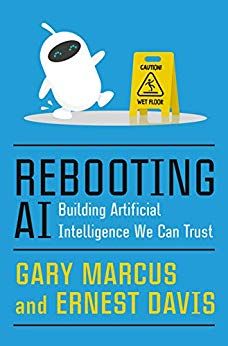
Author: Gary Marcus & Ernest Davis.
Categories: Machine Learning, Deep Learning, Artificial Intelligence.
Why you should read it:
What are we missing in order to achieve a robust AI model? Is Deep Learning enough, or just one part of the solution? According to the authors, Hybrid AI is important, but they argue that it is a necessary but not sufficient condition to achieve a robust AI model.
Similarly to The Book of Why, this book aims to open up a debate between symbolic & connectionist AI, using actionable research to explore what we could and should try next to reach AGI.
Marcus’s position is to have us take a seat while he talks to us and tries to convince us that we need hybrid AI. On the other side, we have Bengio who said, "I don't care what words you want to use, I'm just trying to build something that works." Rebooting AI certainly enriches the debate.
Where you can get it: Buy on Amazon.
Supplement: dedicated book page.
"absolutely brilliant"
— Gary Marcus (@GaryMarcus) February 17, 2020
—Nobel Laureate Danny Kahneman
The Next Decade in AI: Four Steps Towards Robust Artificial Intelligence
It's what I wish I had had time to say at the #AIDebate :)
Finally ready, free, on arXiv. Happy Reading! https://t.co/rbeWGMvqMO
Book Abstract:
Two leaders in the field offer a compelling analysis of the current state of the art and reveal the steps we must take to achieve a truly robust artificial intelligence.
Despite the hype surrounding AI, creating an intelligence that rivals or exceeds human levels is far more complicated than we have been led to believe. Professors Gary Marcus and Ernest Davis have spent their careers at the forefront of AI research and have witnessed some of the greatest milestones in the field, but they argue that a computer beating a human in Jeopardy does not signal that we are on the doorstep of fully autonomous cars or superintelligent machines. The achievements thus far have occurred in closed systems with fixed sets of rules, and these approaches are too narrow to achieve genuine intelligence.
The world we live in is wildly complex and open-ended. How can we bridge this gap? What will the consequences be when we do? Marcus and Davis show us what we need to accomplish before we can get there and argue that if we are wise along the way, we need not worry about a future of machine overlords; we will be able to create an AI that we can trust in our homes, our cars, and our doctor's offices. Rebooting AI provides a lucid, clear-eyed assessment of the current science and offers an inspiring vision of how AI can make our lives better.
Machine Learning Yearning

Author: Andrew Ng.
Categories: Machine Learning, Deep Learning, Strategy & Planning.
Why you should read it:
This book comes from the years of practical experience that Andrew acquired while he led the Deep Learning teams at Baidu and Google Brain. This is one of few resources that show you how to set up your ML/DL projects to work for real. It’ll provide you a compass to help you to efficiently navigate in your experiments, which makes it a must read.
Where you can get it: You can get the latest draft for free.
Just finished writing final few chapters of Machine Learning Yearning book draft, on how to organize and strategize your ML projects. Will send out soon -- sign up at https://t.co/TgvKPa033r if you want a copy!
— Andrew Ng (@AndrewYNg) September 25, 2018
Book abstract:
AI is transforming numerous industries. Machine Learning Yearning, a free book that Dr. Andrew Ng is currently writing, teaches you how to structure Machine Learning projects.
This book is focused not on teaching you ML algorithms, but on how to make ML algorithms work. After reading Machine Learning Yearning, you will be able to:
- Prioritize the most promising directions for an AI project
- Diagnose errors in a machine learning system
- Build ML in complex settings, such as mismatched training/test sets
- Set up an ML project to compare to and/or surpass human-level performance
- Know when and how to apply end-to-end learning, transfer learning, and multi-task learning.
An Introduction to Machine Learning Interpretability (2nd Edition)
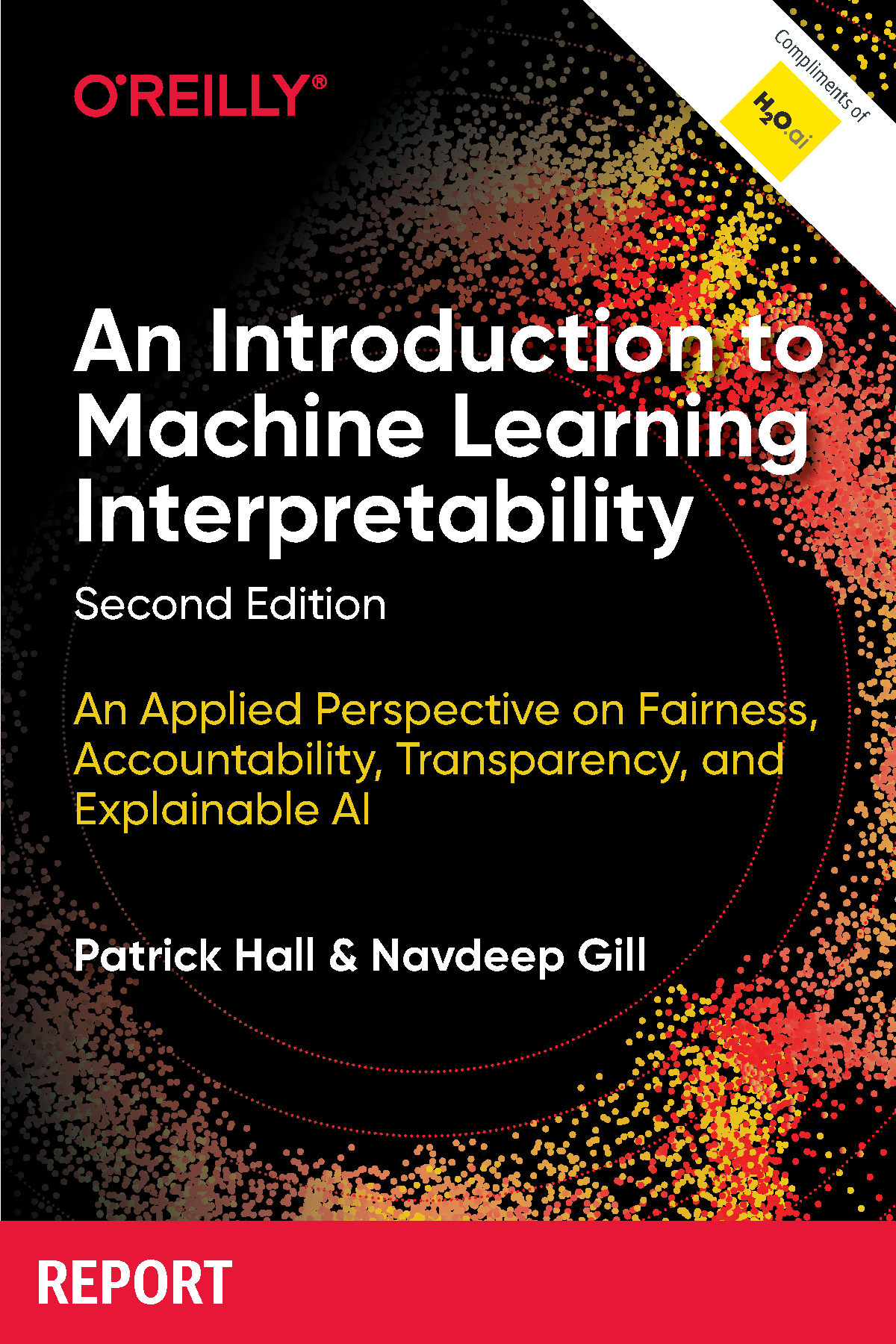
Author: Patrick Hall & Navdeep Gill.
Categories: Machine Learning, Interpretability.
Why you should read it:
It's 2020 and we are deploying more and more models in production, but a key question remains unanswered: do you trust and understand your predictive models? Sooner or later, someone will require your explanations about your models' behaviour. And no, a leap of faith won’t suffice.
Suppose you have cancer and you have to choose between a black box AI surgeon that cannot explain how it works but has a 90% cure rate and a human surgeon with an 80% cure rate. Do you want the AI surgeon to be illegal?
— Geoffrey Hinton (@geoffreyhinton) February 20, 2020
This book is recommended reading for all practitioners wanting to adopt recent and disruptive breakthroughs in debugging, explainability, fairness, and interpretability techniques for machine learning.
Where you can get it: You can download for free here.
[Free eBook] Download An Introduction to Machine Learning Interpretability by @jpatrickhall and @Navdeep_Gill_ to make the most of recent and disruptive breakthroughs in debugging, explainability, fairness & interpretability techniques for #ML: https://t.co/HjM3HeNN2F #AI #XAI pic.twitter.com/hcP1BWQKOi
— H2O.ai (@h2oai) September 4, 2019
Book abstract:
Understanding and trusting models and their results is a hallmark of good science. Analysts, engineers, physicians, researchers, scientists, and humans in general have the need to understand and trust models and modeling results that affect our work and our lives.
Today, the trade-off between the accuracy and interpretability of predictive models has been broken (and maybe it never really existed). But, tools now exist to build accurate and sophisticated modeling systems based on heterogeneous data and machine learning algorithms and to enable human understanding and trust in these complex systems. In short, you can now have your accuracy and interpretability cake…and eat it too
Download this book to learn to make the most of recent and disruptive breakthroughs in debugging, explainability, fairness, and interpretability techniques for machine learning. In this report you’ll find
Definitions and examples
- Social and Commercial Motivations for Machine Learning
- A Machine Learning Interpretability Taxonomy for Applied Practitioner
- Common Interpretability Techniques
- Limitations and Precautions
- Testing Interpretability and Fairness
- Machine Learning Interpretability in Action
Interpretable Machine Learning
A Guide for Making Black Box Models Explainable
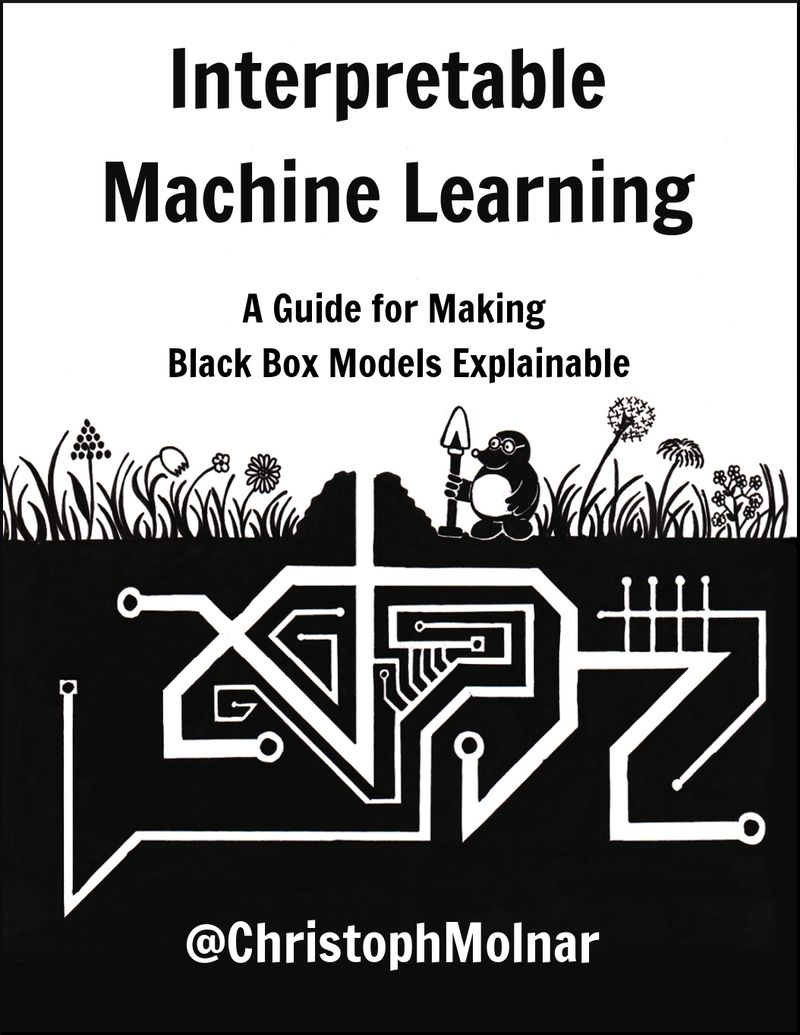
Author: Christoph Molnar.
Categories: Machine Learning, Interpretability.
Why you should read it:
Interpretability is rapidly becoming a hot topic to solve in Deep Learning. Unboxing the black box is still an active research area for Deep Learning, but luckily for Machine Learning models, we actually have more tools available — this being one of the best ones.
Where you can get it: Buy on LeanPub or Lulu (paperback version). You can also read it for free, but if you like it, please support the author.
2 years, 250 pages, 1,219 commits, and 78,480 words:
— Christoph Molnar (@ChristophMolnar) February 21, 2019
I am very proud to say that today I published the 1st edition of "Interpretable Machine Learning". 🎉🎉🎉
Web: https://t.co/s4tyZz3f3B
Leanpub: https://t.co/OAIEB1YNzR pic.twitter.com/6ewrYcgDdb
Book abstract:
Machine learning has great potential for improving products, processes and research. But computers usually do not explain their predictions which is a barrier to the adoption of machine learning. This book is about making machine learning models and their decisions interpretable.
After exploring the concepts of interpretability, you will learn about simple, interpretable models such as decision trees, decision rules and linear regression. Later chapters focus on general model-agnostic methods for interpreting black box models like feature importance and accumulated local effects and explaining individual predictions with Shapley values and LIME.
All interpretation methods are explained in depth and discussed critically. How do they work under the hood? What are their strengths and weaknesses? How can their outputs be interpreted? This book will enable you to select and correctly apply the interpretation method that is most suitable for your machine learning project.
The book focuses on machine learning models for tabular data (also called relational or structured data) and less on computer vision and natural language processing tasks. Reading the book is recommended for machine learning practitioners, data scientists, statisticians, and anyone else interested in making machine learning models interpretable.
Neural Networks and Deep Learning
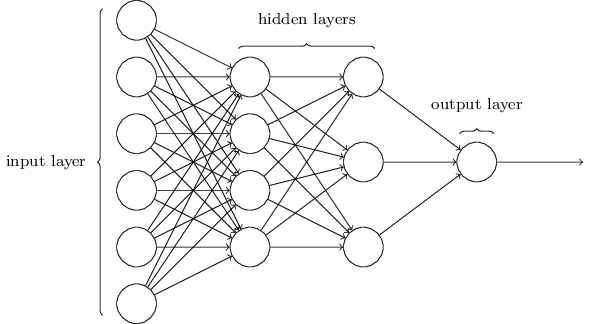
Author: Michael Nielsen
Categories: Machine Learning, Deep Learning.
Why you should read it:
Neural Networks and Deep Learning is THE free online book. Period.
Where you can get it: You can read it for free.
Supplement: You can find the companion code on Github.
Book abstract:
Neural networks are one of the most beautiful programming paradigms ever invented. In the conventional approach to programming, we tell the computer what to do, breaking big problems up into many small, precisely defined tasks that the computer can easily perform. By contrast, in a neural network we don't tell the computer how to solve our problem. Instead, it learns from observational data, figuring out its own solution to the problem at hand.
Automatically learning from data sounds promising. However, until 2006 we didn't know how to train neural networks to surpass more traditional approaches, except for a few specialized problems. What changed in 2006 was the discovery of techniques for learning in so-called deep neural networks. These techniques are now known as deep learning. They've been developed further, and today deep neural networks and deep learning achieve outstanding performance on many important problems in computer vision, speech recognition, and natural language processing. They're being deployed on a large scale by companies such as Google, Microsoft, and Facebook.
The purpose of this book is to help you master the core concepts of neural networks, including modern techniques for deep learning. After working through the book you will have written code that uses neural networks and deep learning to solve complex pattern recognition problems. And you will have a foundation to use neural networks and deep learning to attack problems of your own devising
Generative Deep Learning
Teaching Machines to Paint, Write, Compose, and Play
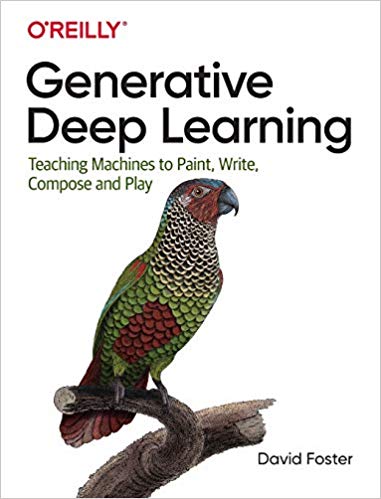
Author: David Foster.
Categories: Machine Learning, Deep Learning, Generative Models.
Why you should read it:
Last year was the year of Generative models, so you’ve probably heard about Generative Adversarial Networks. Remember GPT-2, the AI that was too dangerous to release? Forgetting for a second about the harmful potential that these models have unlocked, Generative models are actually shining as a new tool to empower creatives and artists. From text generation to music composers, they extend the natural artist’s talent in a way that can help overcome any creative block.
Where you can get it: Buy on Amazon or O'Reilly Shop.
Supplement: You can find the companion code on Github.
Book abstract:
Generative modeling is one of the hottest topics in AI. It’s now possible to teach a machine to excel at human endeavors such as painting, writing, and composing music. With this practical book, machine-learning engineers and data scientists will discover how to re-create some of the most impressive examples of generative deep learning models, such as variational autoencoders,generative adversarial networks (GANs), encoder-decoder models, and world models.
Author David Foster demonstrates the inner workings of each technique, starting with the basics of deep learning before advancing to some of the most cutting-edge algorithms in the field. Through tips and tricks, you’ll understand how to make your models learn more efficiently and become more creative.
- Discover how variational autoencoders can change facial expressions in photo
- Build practical GAN examples from scratch, including CycleGAN for style transfer and MuseGAN for music generation
- Create recurrent generative models for text generation and learn how to improve the models using attention
- Understand how generative models can help agents to accomplish tasks within a reinforcement learning setting
- Explore the architecture of the Transformer (BERT, GPT-2) and image generation models such as ProGAN and StyleGAN
Coming Soon
Here’s a little preview of some of this year’s much-anticipated books that you should keep an eye on.
Deep Learning for Coders with fastai and PyTorch: AI Applications Without a PhD

Authors: Jeremy Howard, Sylvain Gugger.
Category: Deep Learning.
Why you should read it:
Seriously, I shouldn’t need to convince you to keep an eye on a book that you have almost certainly already pre-ordered, right?
Where you can get it: Preorder on Amazon, or read for free as Jupyter notebooks on GitHub.
Release: July 14, 2020.
We have a *lot* of really great news to share with you regarding our forthcoming book, "Deep Learning for Coders", thanks to the amazing @OReillyMedia content team.
— Jeremy Howard (@jeremyphoward) February 21, 2020
1: We're expanding it from 350 pages to ~500p, with lots of extra content... https://t.co/guKT7y9VfM
(Of course, if you can afford to buy the book, please do so, especially because it's much easier to read as a book or ebook than it is as a Jupyter Notebook).
— Jeremy Howard (@jeremyphoward) February 21, 2020
Book abstract:
Deep learning has the reputation as an exclusive domain for math PhDs. Not so. With this book, programmers comfortable with Python will learn how to get started with deep learning right away.
Using PyTorch and the fastai deep learning library, you’ll learn how to train a model to accomplish a wide range of tasks—including computer vision, natural language processing, tabular data, and generative networks. At the same time, you’ll dig progressively into deep learning theory so that by the end of the book you’ll have a complete understanding of the math behind the library’s functions.
The Machine Learning Engineering Book
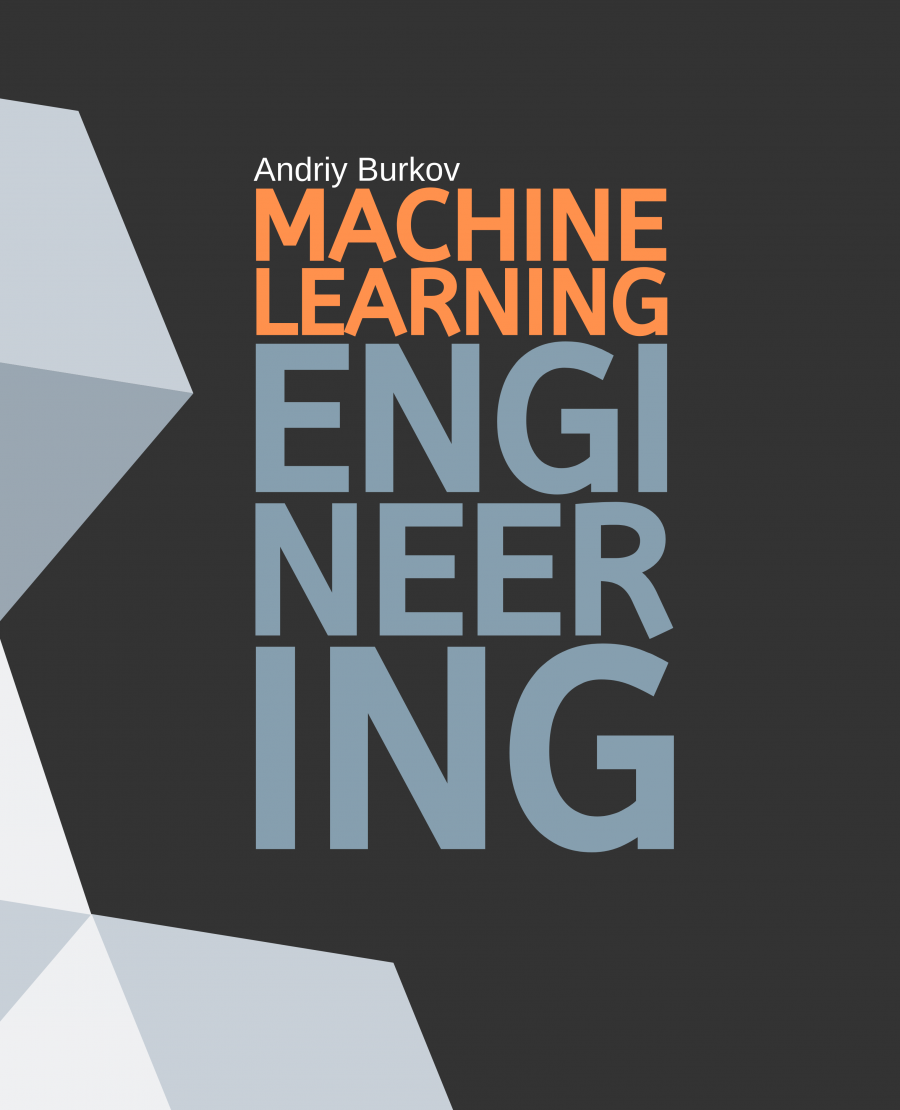
Author: Andriy Burkov.
Categories: Machine & Deep Learning.
Why you should read it:
Andriy is returning after the bestselling The Hundred Page of ML with a sequel, this time focusing on the engineering side of Machine Learning projects. Andriy will bring readers through the various steps of a machine learning pipeline to show the best practices & mental models you can apply to bring these systems from research to production.
Where you can get it: This book is distributed on the “read first, buy later” principle, which means you can freely download the book, read it, and share it with your friends and colleagues, and if you liked the book or found it useful for your work or studies then buy it.
Supplement: You can find the companion wiki.
Release: 2020.
From my upcoming Machine Learning Engineering book. Very few people understand that part or accept it.
— Andriy Burkov (@burkov) November 15, 2019
(The drafts of the first three chapters of the book are available online. The link to the book's website is in the comments.) https://t.co/DNXELzePRG
People often question me about what will be my next project. Below is a small teaser.
— Andriy Burkov (@burkov) July 23, 2019
I already started to work on the book. I have all the material. The book will be likely about 150-200 pages and be distributed as usually on the "read first, buy later"…https://t.co/5fcaqQoMoB
Machine Learning Interviews Book
Author: Chip Huyen.
Categories: Machine & Deep Learning, Interview.
Why you should read it:
This book is currently in stealth mode as the startup that Chip has left NVIDIA to join. But you can get some insight into its content by looking at the terrific and extremely informative articles that Chip has published on her blog. We don't want to put too much pressure on Chip's shoulders, but the community’s general impression is that this will be the "cracking the data science code interview".
Release: 2020.
I'm working on a book on machine learning interviews so I've been spending the last few months talking to companies about their hiring process for ML roles. This thread is a summary of what I've learned. It will be updated as the book progresses. (1/n)
— Chip Huyen (@chipro) July 19, 2019
Human-in-the-Loop Machine Learning
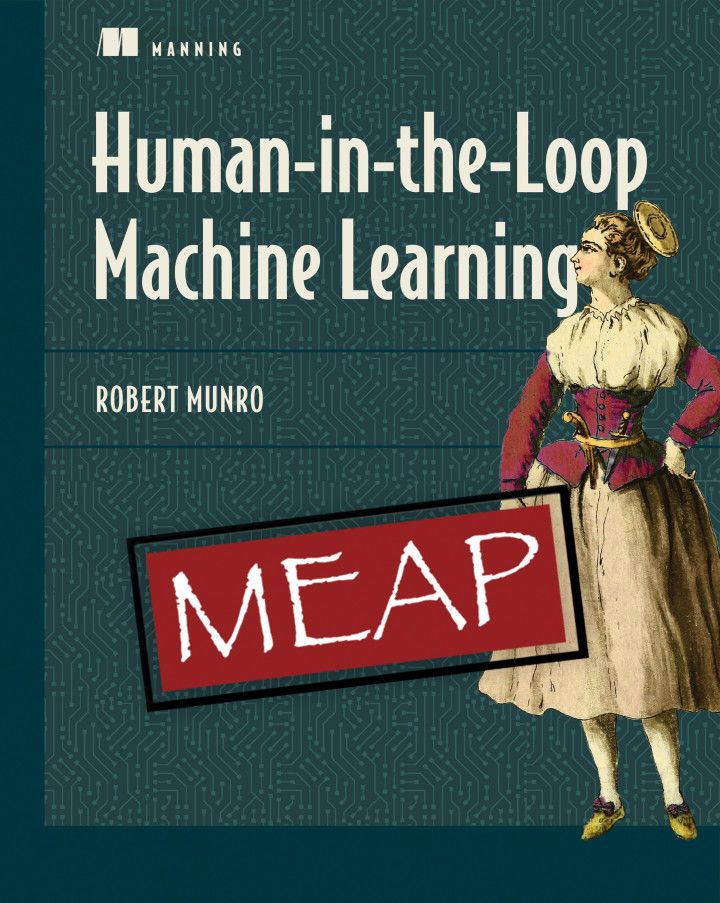
Author: Robert Munro.
Categories: Machine & Deep Learning, Strategy & Planning.
Why you should read it:
Human interaction is central to most Machine Learning projects, from data collection and annotation to output consumption. In this book, Robert shares with readers his experience & algorithms to optimize the human-computer interaction of ML-driven systems. We particularly recommend this book for the readers who want to bridge the gap between how to structure & optimize Machine Learning projects and model development.
Where: Read on Manning publication.
Release: 7 out of 11 chapters available electronically as of March 2020. Remaining chapters and hard-copy coming in early 2020.
Very excited to announce the launch of the book I've been working on, Human-in-the-Loop Machine Learning! https://t.co/WvjSY0UKBX
— Robert (Munro) Monarch (@WWRob) July 9, 2019
The first 3 chapters are available today and we'll be publishing more as we go. All feedback welcome!
Book abstract:
Human-in-the-Loop Machine Learning is a guide to optimizing the human and machine parts of your machine learning systems, to ensure that your data and models are correct, relevant, and cost-effective. 20-year machine learning veteran Robert Munro lays out strategies to get machines and humans working together efficiently, including building reliable user interfaces for data annotation, Active Learning strategies to sample for human feedback, and Transfer Learning. By the time you’re done, you’ll be able to design machine learning systems that automatically select the right data for humans to review and ensure that those annotations are accurate and useful.
There you have it—our most-recommend books on machine learning and deep learning for 2020. Get to reading!

